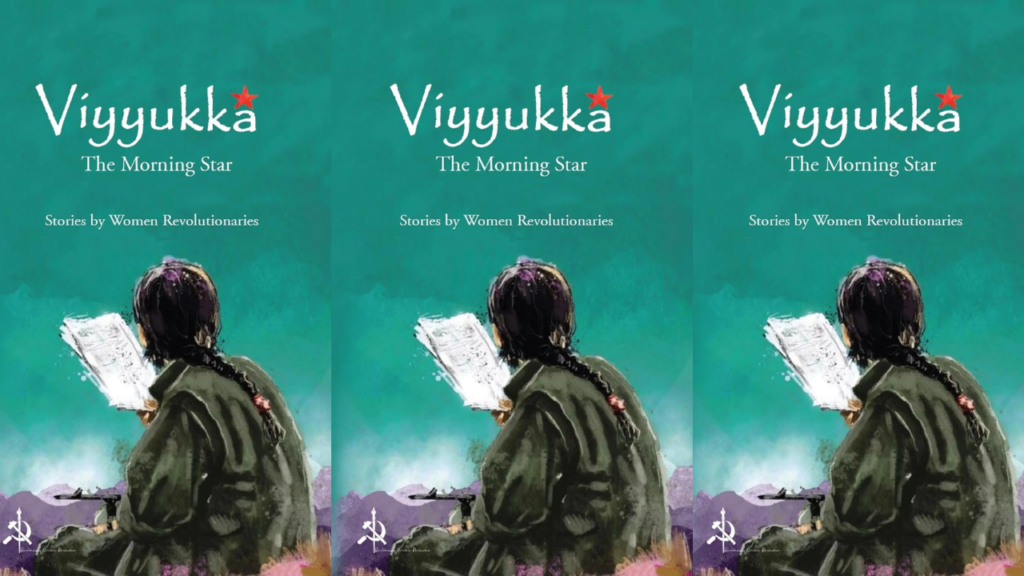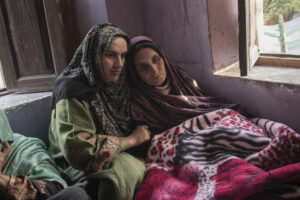

A collection of 20 short stories written by women revolutionaries, titled Viyyukka, meaning “The Morning Star” in Gondi, reflects the Maoist movement in areas of armed struggle in India. It has been published, ironically, at a time when the Central Government is ruthlessly trying to exterminate Maoism, before their self-declared deadline.
While mainstream media often portrays these revolutionaries as “dreaded terrorists” who, like “pests,” “infest” the jungles of Dandakaranya and need to be “combed out” like lice, the stories in Viyyukka depict them as resilient, intelligent, dedicated and hardworking people, full of compassion and tenderness for the Adivasis amongst whom they work.
The Maoist revolutionaries are also shown to be creative and all-rounded in their approach towards both politics and people’s personal lives. In a sad irony, while I was engrossed in this book, an encounter in Bastar on March 29 ended the life of one of the authors who contributed two stories in this collection, Gummadi Renuka.
A leading activist of the Maoist party, Renuka was a lawyer who joined the guerrilla movement. She was a prolific writer, using the pen names B.D. Damayanti and Midko to write numerous articles and short stories for revolutionary magazines. She had also written a booklet on the Salwa Judum, a state-sponsored movement to tackle the Maoist insurgency in which tribal youth were enrolled as Special Police Officers by the police, for a paltry stipend and made to work along with the paramilitary forces to crush the Maoist movement.
The Salwa Judum split the tribal society into those who supported the state venture and those who did not. Villages were uprooted and dumped into camps. The hardships were so many and human rights violations so brutal that the Supreme Court in 2011 ordered that it be disbanded.
The 20 stories in Viyyukka have been translated from Telugu, Gondi, and Hindi magazines brought out by revolutionary groups, before being published into a six-volume collection. For those interested in Marxism, feminism, or social movements, they are unique and fascinating in the way they explore unknown life experiences, debate controversial matters regarding revolutionary violence and justice, demystify romantic notions of tribal life, and widen the boundaries of literary subject matter.
The stories in Viyyukka may seem propagandist as the writers’ aim seems to be to portray an embryonic society in transition (that is now being nipped in the bud by brutal state repression), the struggles of the guerillas who are striving to create it, and the joys and sufferings of the tribal people among whom they work, many of whom are shown to be leading this transition.
These women guerrilla-writers are—to paraphrase W. B. Yeats’ description of the Irish revolutionaries—’birthing terrible beauties’, for the transition process is difficult and painful but aims at creating something beautiful. But within these parameters of the authors’ avowed intentions lie a wide variety of themes, a subtle discourse, layered meanings, and nuances.
Women Activists Face an Extra Burden
Viyyukka reads as a discourse on not only the Maoist movement, but also on women’s agency in it. To use the feminist critic Elaine Showalter’s analysis, it is a female viewpoint that explores an unknown sphere of women’s consciousness: that of women guerrillas and tribal women affected by the Maoist movement in India.
In her seminal 1981 essay, “Feminist Criticism in the Wilderness,” Showalter argued that there is an unknown zone, rarely expressed in literature, that is brought out by women’s writing with which feminist criticism should be concerned.
In this context, both the tribal women and the non-tribal activists who set out on the path of revolution have many hurdles to overcome, such as challenging the assumed roles they are expected to play, of being a dutiful daughter, wife, and mother, and the patriarchal thought process that they have themselves internalized. Moreover, the ruthless efforts of the state to crush this movement mean that they have to face a great deal of risk to their personal lives and liberty.
The doubts in the minds of these women guerrillas and the tribal women they work with—their fears and hopes, their struggle to overcome these fears, their emotional turmoil, their courage and bravery—form the unknown subject matter in this collection. Along with this, the unusual experiences of motherhood, man-woman relationships, and family sharpen the gender axis of the stories.
Women activists face an extra burden. Not only do they have to fight against class, caste, the state, feudal forces, and other systems of exploitation and oppression, but they have to fight against patriarchy as well. While male activists support and join in this fight, women alone experience their personal struggle, whether with the family against parental pressure and forced marriage, or the struggle against the patriarchal state during armed combat.
Gender Politics in Viyyukka
“Why I became a Guerrilla” is an autobiographical account by Budri, a woman from the Kuyi tribe who narrated her story in Kuvvi to Vasudha. Driven out of their lands by the “Munsab,” her grandparents move to another village with their family while Budri’s father and uncle, trying to fight for their land, remain in hiding. Later, Budri realizes that they are with the Maoists.
On a chance meeting with her father, he explains to her how, in Narayanpatna, outsiders like Brahmins, Vaisyas, and others had forcibly occupied the lands of many tribal people, and the government was doing nothing about it. She also observes how her brother and others in the village died of fever, which her grandfather tried to cure with traditional medicine. She understands that the government is indifferent to the health of her people.
A day comes when her father takes them back to their old village, where the Maoists have confronted the Munsab and retrieved Budri’s family’s land. Now party meetings are held here, and Budri loves the songs that are sung there. Slowly, she becomes a cultural activist, against the wishes of her mother and grandmother, and then joins the rebels after her sister.
“Bali” is set in Gadchiroli, written by Nirmala Uppuganti aka Narmada Akka under the pen name Nitya. She was arrested in 2019 while undergoing treatment for cancer in a hospital in Hyderabad, incarcerated in Byculla Jail, Mumbai, and passed away on 9th April, 2022, at a hospice under judicial custody.
While many intellectuals and artists romanticize the egalitarian structure of tribal society, this story brings out the patriarchy within Gond society, something that the Maoist movement is also trying to deal with. The story discusses an issue that Dr. B.D. Sharma has also highlighted in his writings the custom of forced marriages among tribals in Bastar.
Bali is being brutally tortured by her father because she will not marry the man of his choice. She is a schoolgirl and wants to decide her own fate. She tries to resist her father’s beatings and torture in many ways, but ultimately her father has his way. She runs away from her newly married life to her classmate’s house, where her friend’s mother suggests that she marry another boy, much better than her present husband. However, her father arrives, bundles her into a jeep, and drops her back off at her in-laws’ residence.
Here, while washing vessels by the river, she chances to meet two women squad members and immediately pours out her miseries. She is invited to attend a meeting where the President of the Revolutionary Janatana Sarkar speaks against the patriarchal customs of their own society, about Gond women not being allowed to sow seeds, enter a granary, being confined to a separate hut called “kurmalonu” during menstruation, and the custom of forced marriages.
The revolutionary committee declares Bali’s marriage as dissolved and that she is free to live alone and marry a man of her choice. As the squad leaves the village, Bali packs a small bag and calls out to them to wait for her.
Other stories also explore these themes. B. Anuradha’s “Diku” describes the women’s movement in the interiors of Jharkhand and the role of the women guerrillas in solving questions of marriage and sexual assault faced by women in rural areas. “Marriage” by Tayamma Karuna upholds a woman’s right to be single in areas where marriage is a given.
“Ramko” again by Nitya and “Encounter” by Vasudha, depict particular instances where, in each story, guerrilla women single-handedly ward off their arrests when surrounded by the state forces, showing not only exemplary courage, but also intelligence and presence of mind.
Counternarratives to the Mainstream “Sandwich Theory”
The collection has stories that describe the faith and support of the villagers and the Gond community as they ward off the police and save the squad members and underground activists undergoing severe torture themselves. From Anala’s “Tender Hands,” which describes a young boy’s travails in saving his absconding brother, to “The Story of an Arrest” by Bharati, where two girls face torture as they “cry wolf” to save time for the squad to escape.
“Red Flag” by Shweta is a tender account of how an elderly Adivasi couple, who, after their village has been raided and everything destroyed, dig out the red flag that they had carefully hidden as people would their gold ornaments. These stories come out as an alternative to the “sandwich theory” narrative in mainstream discourse, where journalists and writers describe the Adivasis as “sandwiched” between the state machinery and the Maoists, both of whom are exploiting and threatening them.
In “Defiance”, Asifa uses a particularly poignant female form to describe a non-violent act of rebellion that immediately brought to mind the story “Draupadi” by Mahasweta Devi. After rampaging in a village, a policeman picks up an infant. When its mother struggles to claim the baby, who is sick, the policeman refuses to believe that she is either married or a mother. When told that she can have her baby if she can prove her motherhood, Somari angrily uncovers herself and sprays the policeman’s face with breast milk.
In “She is my Daughter”, another story by Midko, Bhime keeps insisting that the dead body of a woman guerrilla is that of her daughter, just to claim the body so that the body of this activist, whose parents have joined the Salwa Judum, gets a decent cremation. “Three Mothers” by Padmakumari poignantly describes the feelings of women whose offspring have been killed in encounters and the mental trauma they face collecting the dead bodies.
The front page story in The Indian Express this past April was about 19-year-old Jyoti Hemla of Bijapur, who joined the Maoists after studying at a portacabin school. l She was killed in the massive encounter in Indravati National Park on February 9th, 2025, in which 31 Maoists, including Renuka alias Midko, lost their lives. Many intellectuals, activists, and analysts continue to question whether this movement is worth the number of lives lost.
In some ways, the women guerrilla-authors of Viyyukka have attempted to discuss these questions. “Little Red Guards” by Shaheeda talks about the Bal Sanghams and mobile schools of the Maoists. It appears that the embryonic society supervised by the alternate government of the Maoists (called Janatana Sarkar) is trying to provide an alternative education and outlook to children. Her story describes the love the children have for this education, which emphasizes their responsibility to help the elderly people in their village.
Rising Hindutva and Capital Punishment
“Adivasis and Untouchability” by Tayamma Karuna is a nuanced exploration of how the rising Hindutva ideology is affecting tribal society. A Baba (godman) has been organizing workshops in the forest area, inviting people from the Gond community to attend and reform themselves. As a result, a chasm between Adivasis who are now vegetarians and teetotalers and those who are not is dividing up families and the entire village.
In anger, the local squad has demolished a Shiv Temple, and during the next meeting with the squad, the villagers are really uneasy. Sensing distrust, the leading members of the party who are visiting, gently persuade the squad and through it the people, that the temple desecration was not the solution to this problem. They appeal to them to consider the good and bad that have happened due to the godman’s interference.
For instance, the Baba had perhaps been more successful than they in teaching people self-control over alcohol, but by making meat-eaters into “untouchables,” he was destroying the original Adivasi culture and practices. After the local squad admits its wrong understanding of the villagers, they can create some harmony amongst them. The story portrays the Maoist party as flexible in its approach.
Similarly, Midko’s “Punishment” has a dialectical approach towards capital punishment. Boklu and Mangal are two village youths who joined the Salwa Judum (Peace March in Gondi) and are repentant.
Boklu and Mangal have come back to the village, and many of the villagers are out for their blood. Gulari, a young woman who was raped, not by these two, but by other Salwa Judum people, will not even allow them to touch her son. As the squads and Janatana Sarkar members meet and discuss the issue, it is decided that they be spared, as many of those who joined the Judum had been brainwashed by the police and are, after all, part of the community.
However, due to the social boycott of their village folk, the duo has neither work nor food for survival. They wander through the forests and end up with a tribal landlord who had been instrumental in facilitating their recruitment by the police. But Boklu and Mangal are tormented by their own plight. They return to the village, where they are again aggressively confronted for having run away. It is only when they show the villagers the gory head of the Gond landlord whom they have decapitated that the villagers accept them. The Maoist leadership later criticized the villagers for having left Boklu and Mangal in such a situation that they were forced to prove their commitment in this violent way.
Brutal Repression Only Leads to Rebellion
The last story, “The Forward March of History” by Ankita, explores the musings of a woman guerrilla at a time when the movement is on a decline. Villagers who had staunchly defended them are now under police pressure following the state propaganda, and she is remembering her partner, who works in another area of the movement, and his words about keeping emotions based on reality. This, she realizes, would be a passing phase, for brutal repression only leads to rebellion, and the flames of revolution will again be kindled, is what she feels.
As women-centric stories written by women, one theme that is missing in this collection is the experience of patriarchal thinking and practice within the Maoist movement, and the inner party struggle over it. Perhaps the larger collection of stories yet not been translated has grappled with the issue. Much literature is available to show that the mobilization of women in the militia, guerrilla army, and mass organizations in Maoist areas has been immense, and that women have outshone men in many instances in their military and organizational skills.
Nonetheless, in the initial days, it must have been a struggle for women for inclusion, acceptance, and promotion. An exploration of gender dynamics within a man-woman relationship in the guerrilla zone could have also been a subject of interest to readers. Perhaps more translations and the surfacing of more such experiential stories would add newer dimensions to the writings of revolutionary women.
As a person unfamiliar with Telugu and having never had exposure to Gondi, I cannot judge these stories as translations. Falling within the general framework of realism or social realism as a genre, very much part of the Indian tradition of contemporary story writing, the selection in Viyyukka does manage to engage the reader who is socially aware.
Since the art of the short story depends, like a poem, on saying things concisely, the stories do manage to discuss different aspects of a theme. The short story traditionally works around the twist at the end, a device that is not usually practiced in contemporary writing, and the stories of Viyyukka also sometimes use it and sometimes work as thought-provoking descriptions or narrations.
The stories manage to create an atmosphere quite vividly for urban readers unfamiliar with it, drawing up interesting characters and intriguing situations. However, how these stories will work for the general reader, those uninterested in the Maoist movement, is something that time will tell.





